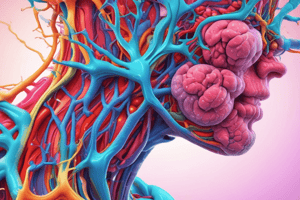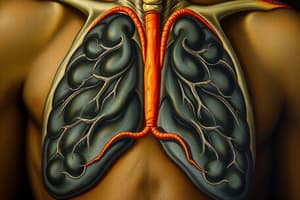Podcast
Questions and Answers
What is the primary function of the hypothalamus in the endocrine system?
What is the primary function of the hypothalamus in the endocrine system?
- Serves solely as a sensory processing center
- Regulates the autonomic nervous system (correct)
- Produces hormones directly into the bloodstream
- Stores hormones until needed
The anterior pituitary is primarily composed of neural tissue.
The anterior pituitary is primarily composed of neural tissue.
False (B)
What are the two main types of hormones produced by the pituitary gland?
What are the two main types of hormones produced by the pituitary gland?
Anterior and posterior pituitary hormones
The stalk connecting the hypothalamus to the pituitary gland is known as the ______.
The stalk connecting the hypothalamus to the pituitary gland is known as the ______.
Which hormone stimulates the proliferation of chondrocytes to increase bone growth?
Which hormone stimulates the proliferation of chondrocytes to increase bone growth?
Match the types of hormones to their respective sources:
Match the types of hormones to their respective sources:
ACTH stimulates the secretion of thyroid hormones.
ACTH stimulates the secretion of thyroid hormones.
Which part of the pituitary gland releases hormones synthesized in the hypothalamus?
Which part of the pituitary gland releases hormones synthesized in the hypothalamus?
The intermediate pituitary plays a major role in mammals.
The intermediate pituitary plays a major role in mammals.
What is the primary function of FSH in males?
What is the primary function of FSH in males?
What is the major role of the hypothalamo-pituitary axis?
What is the major role of the hypothalamo-pituitary axis?
LH is responsible for the _______ in females.
LH is responsible for the _______ in females.
Match the hormones with their primary function:
Match the hormones with their primary function:
Which receptor type does prolactin utilize?
Which receptor type does prolactin utilize?
Neurohormones released by the hypothalamus enter the general circulation immediately.
Neurohormones released by the hypothalamus enter the general circulation immediately.
Name the pathway which TSH activates to stimulate thyroid hormone synthesis.
Name the pathway which TSH activates to stimulate thyroid hormone synthesis.
What hormone is primarily responsible for the regulation of extracellular fluid?
What hormone is primarily responsible for the regulation of extracellular fluid?
Oxytocin is secreted by the anterior pituitary gland.
Oxytocin is secreted by the anterior pituitary gland.
Which gene is responsible for the production of MSH and β-LPH?
Which gene is responsible for the production of MSH and β-LPH?
Vasopressin is another name for __________.
Vasopressin is another name for __________.
Match the hormones with their corresponding cell types in the anterior pituitary:
Match the hormones with their corresponding cell types in the anterior pituitary:
What effect does growth hormone (GH) have on adipose tissue?
What effect does growth hormone (GH) have on adipose tissue?
The plasma half-life of ADH is between 10-15 minutes.
The plasma half-life of ADH is between 10-15 minutes.
What reflex does oxytocin trigger during milk ejection?
What reflex does oxytocin trigger during milk ejection?
What primarily regulates prolactin (PRL) secretion in mammals?
What primarily regulates prolactin (PRL) secretion in mammals?
Hypothalamic factors consist of large proteins synthesized in the anterior pituitary.
Hypothalamic factors consist of large proteins synthesized in the anterior pituitary.
What is the role of the suprachiasmatic nucleus in hormone regulation?
What is the role of the suprachiasmatic nucleus in hormone regulation?
The __ feedback loop involves hormones from target glands feeding back to the pituitary and hypothalamus.
The __ feedback loop involves hormones from target glands feeding back to the pituitary and hypothalamus.
Match each hormone with its corresponding hypothalamic control:
Match each hormone with its corresponding hypothalamic control:
Which type of signal is released by the hypothalamus and delivered to the pituitary gland?
Which type of signal is released by the hypothalamus and delivered to the pituitary gland?
Pulsatile secretion of hormones can prevent down regulation of receptors.
Pulsatile secretion of hormones can prevent down regulation of receptors.
What is the consequence of continuous hormone secretion on receptor regulation?
What is the consequence of continuous hormone secretion on receptor regulation?
Flashcards are hidden until you start studying
Study Notes
Hypothalamus-Pituitary Axis
- The hypothalamus is the major integration center for the autonomic nervous system and most of the endocrine system.
- It processes most sensory information and is part of the brain.
- The pituitary gland is small and attached to the hypothalamus.
- The pituitary gland has three parts: posterior, intermediate, and anterior.
- The posterior lobe contains neurons from the hypothalamus.
- The anterior lobe is the major endocrine part (composed of glandular tissue).
- The intermediate lobe has a major function in amphibians and fish (produces MSH).
- The anterior lobe and the intermediate lobe are often considered as the anterior pituitary.
Hypothalamic-Pituitary Pathway
- The hypothalamus is composed of neuroendocrine cells.
- Hypothalamic neuroendocrine cells either:
- Project axons down to the posterior pituitary lobe.
- Release factors into the pituitary stalk portal venous system, which feeds the anterior pituitary.
- Endocrine cells in the anterior and intermediate pituitary release their hormones into a second capillary network, where they enter systemic circulation.
Intermediate Pituitary
- In mammals, the intermediate pituitary produces:
- MSH (melanocyte-stimulating hormone) which increases skin pigment.
- β-LPH (β-lipotropin) which is degraded to β-endorphin, providing analgesia during stress.
- Both MSH and β-LPH are derived from the common gene POMC (pro-opiomelanocortin).
Posterior (Nervous) Pituitary
- The posterior pituitary releases ADH (antidiuretic hormone or vasopressin) and oxytocin, produced by hypothalamic neurons.
- These hormones are transported along axons in vesicles to the pituitary.
- Hormones are stored in nerve endings and released when an action potential is fired.
- After secretion, hormones diffuse into blood vessels.
- The plasma half-life of these hormones is 3-5 minutes.
Anti-Diuretic Hormone (ADH)
- ADH is the most important regulator of extracellular fluid.
- It acts in the kidneys to regulate the density of aquaporins (water channels) in the distal tubule and collecting duct.
- ADH increases water reabsorption.
- ADH secretion is primarily regulated by hypothalamic osmoreceptors and stretch receptors in blood vessels.
Oxytocin
- Oxytocin primarily acts on:
- Uterus smooth muscle: contraction during parturition.
- Mammary gland: contraction increases pressure to drive milk towards excretory ducts and teats (milk ejection reflex).
- The oxytocin receptor is a G-coupled receptor that activates PLC (Ca pathway).
- Oxytocin secretion is regulated by several reflexes.
Anterior Pituitary (Master Gland)
- The anterior pituitary contains five different cell types that produce six different hormones.
- These hormones are proteins or glycoproteins with longer half-lives than their releasing hormones.
- The six hormones produced by the anterior pituitary are:
- TSH (thyroid-stimulating hormone) produced by thyrotrope cells.
- LH & FSH (gonadotropins) produced by gonadotrope cells.
- ACTH (adrenocorticotropic hormone) produced by corticotrope cells.
- GH (growth hormone) produced by somatotrope cells.
- PRL (prolactin) produced by mammotrope (lactotrope) cells.
- These hormones are tropic, meaning they regulate other endocrine glands.
- They are directly controlled (positively and/or negatively) by the hypothalamus.
Function of Anterior Pituitary Hormones
-
GH (somatotropin) binds to a cytokine receptor type:
- Direct effects: stimulates lipolysis and reduces lipogenesis in adipose tissue (catabolic); promotes protein synthesis (anabolic).
- Indirect effects: stimulates the synthesis of IGF1 (somatomedin) and its binding proteins in the liver. IGF1 stimulates chondrocyte (cartilage cells) proliferation to increase bone growth; it stimulates satellite cells in muscle (muscle fiber growth); promotes amino acid uptake and protein synthesis.
-
TSH (thyrotropic hormone) binds to a G-coupled receptor on follicular cells in the thyroid gland:
- It stimulates the cAMP pathway, which, in turn, stimulates the synthesis of thyroid hormones (covered in more detail later).
-
ACTH (adrenocorticotropic hormone) binds to a G-coupled receptor, stimulating the cAMP pathway:
- It stimulates the mobilization of cholesterol in the adrenal cortex, increasing the substrate for cytochrome P-450 and thereby increasing the release of corticosteroids.
-
LH binds to a G-protein coupled receptor (cAMP pathway):
- In males, it stimulates testosterone production by Leydig cells in the testes.
- In females, LH controls sex steroid production by the ovary and is responsible for ovulation (LH surge).
-
FSH binds to a G-protein coupled receptor (cAMP pathway):
- In males, it stimulates the secretion of inhibin by Sertoli cells.
- In females, it promotes the development of follicles and the secretion of sex steroids.
-
PRL (prolactin) binds to a cytokine receptor type:
- It stimulates the synthesis of milk proteins (casein, lactalbumin).
- In poultry, it is responsible for the initiation and maintenance of incubation behavior (broodiness).
Hypothalamic Control of Anterior Pituitary
- Neurohormones released by the hypothalamus are secreted in small amounts, bypassing general circulation.
- Hypothalamic neurons receive information from:
- Higher brain centers, emotions.
- External environmental and social stimuli.
- Internal rhythms.
- Metabolic state (temperature, energy level, osmolarity).
- Endogenous hormones via feedback.
Hypothalamic Releasing and Inhibitory Hormones
- Hypothalamic releasing and inhibitory hormones are all relatively small peptides, generally fragments from a larger proprotein.
- Different releasing hormones are synthesized by specific neurons.
- Releasing hormone precursors are made in cell bodies and transported down axons to nerve endings for storage.
- Electrical stimulation leads to the release of releasing hormones from the hypothalamus, which are delivered to the pituitary by the portal system, causing the release of hormones by the pituitary, ultimately resulting in the release of the final hormone in the target gland. This signifies an amplification of the signal at each step.
Pulsatility
- Many hormones from the hypothalamus and pituitary are released in a pulsatile or episodic manner.
- This is regulated by the biological clock of the hypothalamic suprachiasmatic nucleus.
- Pulsatile secretion prevents the downregulation of receptors from continuous hormone exposure.
- Pulsatile frequency can trigger specific actions.
Feedback Control
- Circulating hormones from endocrine glands provide negative feedback to both the hypothalamus and pituitary.
- This feedback serves to regulate hormone secretion.
- There are two major feedback loops:
- Short loop: pituitary hormones feed back to the hypothalamus.
- Long loop: hormones from target glands feed back to the pituitary and hypothalamus.
Studying That Suits You
Use AI to generate personalized quizzes and flashcards to suit your learning preferences.




